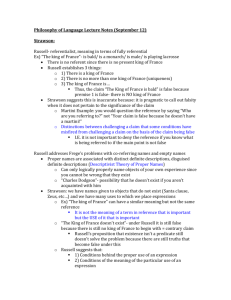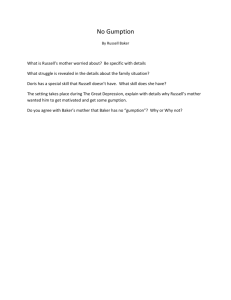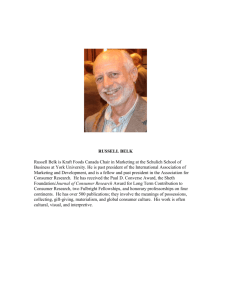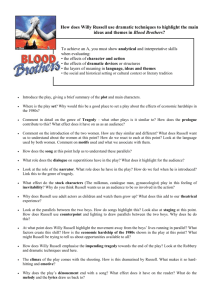JP Russell - Impressionism.qxd - Art Gallery of Western Australia
advertisement
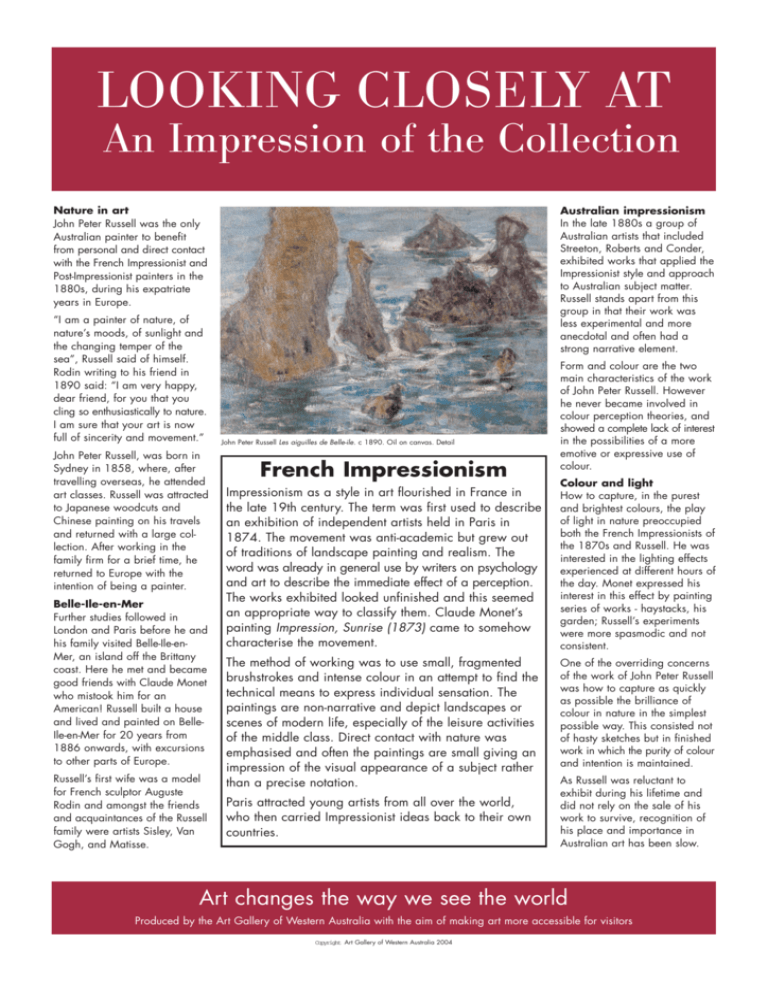
LOOKING CLOSELY AT An Impression of the Collection Nature in art John Peter Russell was the only Australian painter to benefit from personal and direct contact with the French Impressionist and Post-Impressionist painters in the 1880s, during his expatriate years in Europe. “I am a painter of nature, of nature’s moods, of sunlight and the changing temper of the sea”, Russell said of himself. Rodin writing to his friend in 1890 said: “I am very happy, dear friend, for you that you cling so enthusiastically to nature. I am sure that your art is now full of sincerity and movement.” John Peter Russell, was born in Sydney in 1858, where, after travelling overseas, he attended art classes. Russell was attracted to Japanese woodcuts and Chinese painting on his travels and returned with a large collection. After working in the family firm for a brief time, he returned to Europe with the intention of being a painter. Belle-Ile-en-Mer Further studies followed in London and Paris before he and his family visited Belle-Ile-enMer, an island off the Brittany coast. Here he met and became good friends with Claude Monet who mistook him for an American! Russell built a house and lived and painted on BelleIle-en-Mer for 20 years from 1886 onwards, with excursions to other parts of Europe. Russell’s first wife was a model for French sculptor Auguste Rodin and amongst the friends and acquaintances of the Russell family were artists Sisley, Van Gogh, and Matisse. Australian impressionism In the late 1880s a group of Australian artists that included Streeton, Roberts and Conder, exhibited works that applied the Impressionist style and approach to Australian subject matter. Russell stands apart from this group in that their work was less experimental and more anecdotal and often had a strong narrative element. John Peter Russell Les aiguilles de Belle-ile. c 1890. Oil on canvas. Detail French Impressionism Impressionism as a style in art flourished in France in the late 19th century. The term was first used to describe an exhibition of independent artists held in Paris in 1874. The movement was anti-academic but grew out of traditions of landscape painting and realism. The word was already in general use by writers on psychology and art to describe the immediate effect of a perception. The works exhibited looked unfinished and this seemed an appropriate way to classify them. Claude Monet’s painting Impression, Sunrise (1873) came to somehow characterise the movement. The method of working was to use small, fragmented brushstrokes and intense colour in an attempt to find the technical means to express individual sensation. The paintings are non-narrative and depict landscapes or scenes of modern life, especially of the leisure activities of the middle class. Direct contact with nature was emphasised and often the paintings are small giving an impression of the visual appearance of a subject rather than a precise notation. Paris attracted young artists from all over the world, who then carried Impressionist ideas back to their own countries. Form and colour are the two main characteristics of the work of John Peter Russell. However he never became involved in colour perception theories, and showed a complete lack of interest in the possibilities of a more emotive or expressive use of colour. Colour and light How to capture, in the purest and brightest colours, the play of light in nature preoccupied both the French Impressionists of the 1870s and Russell. He was interested in the lighting effects experienced at different hours of the day. Monet expressed his interest in this effect by painting series of works - haystacks, his garden; Russell’s experiments were more spasmodic and not consistent. One of the overriding concerns of the work of John Peter Russell was how to capture as quickly as possible the brilliance of colour in nature in the simplest possible way. This consisted not of hasty sketches but in finished work in which the purity of colour and intention is maintained. As Russell was reluctant to exhibit during his lifetime and did not rely on the sale of his work to survive, recognition of his place and importance in Australian art has been slow. Art changes the way we see the world Produced by the Art Gallery of Western Australia with the aim of making art more accessible for visitors Copyright Art Gallery of Western Australia 2004 LOOKING CLOSELY AT John Peter Russell A non-conventional perspective Many of the Impressionist painters had an interest in Japanese prints and photography and incorporated non-Western perspective, simple outlines, lack of modelling, flat areas of colour, and other stylistic elements into their work. Conventional perspective is not employed in this work. There is a flattening of the scene and the sky does not seem to be separated from the sea. The horizon is not obvious. Distance and perception What do you see if you stand close to the painting? What then happens when you step back and view it from a distance? Does the colour change? Do you see different colours? What detail do you see when close? Do you see the scene differently from a distance? Mood Russell has been quoted as saying that he wanted to paint nature’s moods. Do you think he has succeeded? Does what you are looking at affect your mood? Size and scale Do you know how big these rocks are? What is the size of each element in relation to each other? How far can you see? There is nothing in the distance by which you are able to estimate and judge size and scale in the work. Are you uncomfortable with this seeming lack of detailed information? What does the shape of the rocks tell you about the nature of this place? Do these rocks give you an indication of what the coast is like? There is movement in the water which tells you about the wind and the weather and if this is a dangerous coast. Artist’s viewpoint What is the artist’s viewpoint of this scene? Where is he positioned in relation to the rocks - above or below them? John Peter Russell Les aiguilles de Belle-Ile. c 1890. Oil on canvas Impressionism in Australia Russell is separated from other Australian Impressionist artists in that there is no narrative in his work. The emphasis is on the landscape; there are no people engaged in activities by which the artist is telling a story. It is the artist’s intention to depict the power and magnitude of nature. Artists at Belle-Ile Monet also painted these rocks at Belle-Ile. Both Monet and Russell were trying to capture the changing mood and light. Russell speaks of trying to capture the “changing temper of the sea”. The artist is also trying to share his experience with the viewer by describing the mood and atmosphere on a particular day. What mood do you think is represented? Principal Partner 2004 Brushstrokes Notice that the texture and pattern of the brushstrokes changes in various areas of the painting. What kind of brushstrokes are there? Has only one kind of brush been used or can you see a variation in the brushstrokes? Is there a sense of urgency about the work or has it been carefully considered? Both thick and thin paint has been used.



